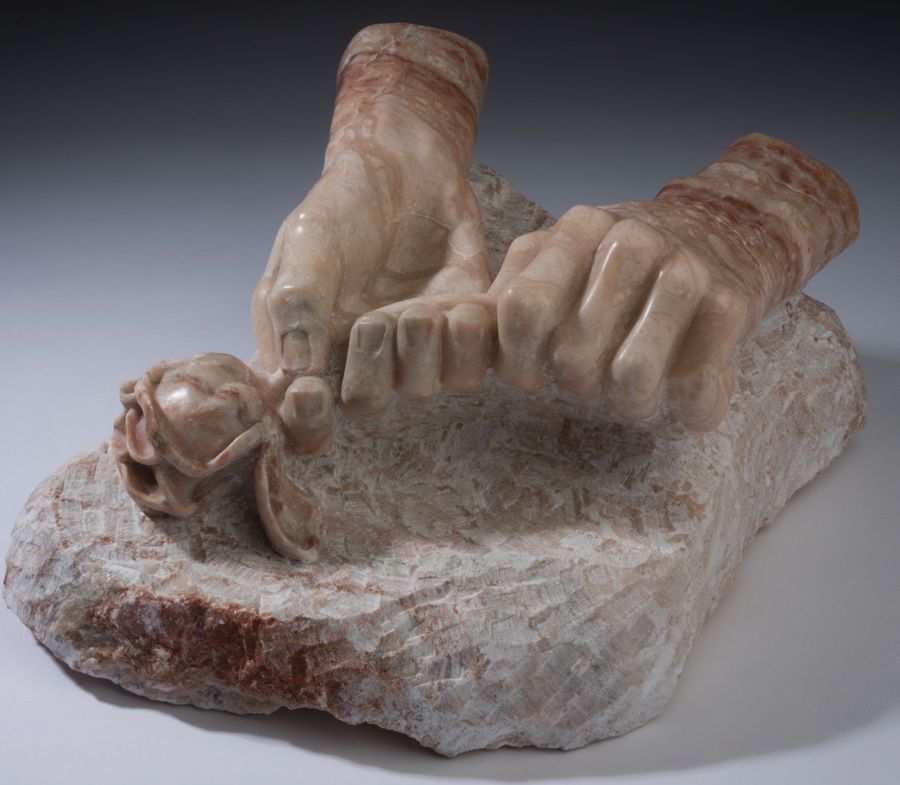
The ‘Noble Rose’ Sculpture
 After retiring from clinical duties in 2017, neurosurgeon ROBERT MARTUZA ’69 put his skilled hands to use as a sculptor while also continuing research on oncolytic viruses for cancer therapy. Of the sculptures he’s created in his workshop in Marblehead, Mass. — where he lives with his wife of 50 years, S. JILL PFIFER MARTUZA ’69, whom he met their first year at Bucknell — one of his favorites is Noble Rose: Beautiful Forever.
After retiring from clinical duties in 2017, neurosurgeon ROBERT MARTUZA ’69 put his skilled hands to use as a sculptor while also continuing research on oncolytic viruses for cancer therapy. Of the sculptures he’s created in his workshop in Marblehead, Mass. — where he lives with his wife of 50 years, S. JILL PFIFER MARTUZA ’69, whom he met their first year at Bucknell — one of his favorites is Noble Rose: Beautiful Forever.
Inset: Martuza’s Noble Rose: Beautiful Forever sculpture.

Inset: Martuza’s Noble Rose: Beautiful Forever sculpture.
The ‘Noble Rose’ Sculpture
 After retiring from clinical duties in 2017, neurosurgeon ROBERT MARTUZA ’69 put his skilled hands to use as a sculptor while also continuing research on oncolytic viruses for cancer therapy. Of the sculptures he’s created in his workshop in Marblehead, Mass. — where he lives with his wife of 50 years, S. JILL PFIFER MARTUZA ’69, whom he met their first year at Bucknell — one of his favorites is Noble Rose: Beautiful Forever.
After retiring from clinical duties in 2017, neurosurgeon ROBERT MARTUZA ’69 put his skilled hands to use as a sculptor while also continuing research on oncolytic viruses for cancer therapy. Of the sculptures he’s created in his workshop in Marblehead, Mass. — where he lives with his wife of 50 years, S. JILL PFIFER MARTUZA ’69, whom he met their first year at Bucknell — one of his favorites is Noble Rose: Beautiful Forever.She lived to be two weeks shy of 103. I made Noble Rose: Beautiful Forever in honor of her 100th birthday. In Lithuanian, her name is Adele Roze; in English, it’s Adeline Rose — “noble rose.” The sculpture is of two arthritic hands holding a wilting rose, representing my mother going through the process of aging and showing its beauty.
My sculptures combine Italian and Japanese design philosophies into something I call “figurative haiku.” They’re figurative, like Italian sculpture. You can see the hands, which are fairly detailed, but like haiku, it’s simplistic — there’s no person, no body, no table.
In Japan, there’s an aesthetic called wabi-sabi. “Wabi” refers to the faults and quirks that arise in the process of making something, which adds uniqueness and elegance to that object. “Sabi” concerns the aging process and the beauty that comes with it, and also the idea of impermanence. With wabi-sabi, you’d enjoy the wrinkles that you’ve earned and appreciate the process of aging. What I wanted to communicate with this sculpture is that there is beauty in aging. If you develop wrinkles over time, it’s because you’ve done something. If you develop arthritis, it’s because your hands have been used. We should appreciate those things.
Overall, I’m pleased with how it came out. It expresses exactly what I wanted to say, and that is, here’s a rose, which is beautiful — but a rose in the process of wilting and dying is magnificent. Wabi-sabi!
— As told to David Pulizzi
